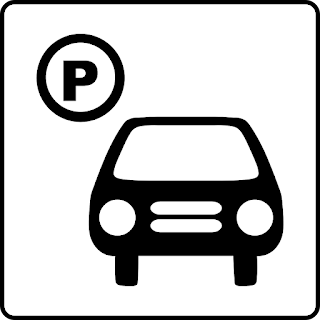Skip to main content
Posts
There are 10 parking spaces numbered from 101 to 110. At least one car
is parked in these slots. If cars can be parked only at the
consecutively numbered parking slots, how many such arrangements can be
made.
Consider that only one car can be parked in one parking slot and
all cars are identical.
Here is the possible count!
What was the puzzle?
Suppose there is only 1 car that is to be parked in 1 of the 10 slots.
Number of possible arrangement = 10C1 = 10!/1!9 = 10.
That is 1 car can be parked in 10 slots in 10 number of ways.
Now, let's suppose that there are 2 cars that to be parked in 2 of the 10 parking slots. But the condition is that they need to be parked in consecutive slots.
Among 10 slots for there are 9 possible consecutive slots for 2 cars. That is, 2 cars can be parked in consecutive slots in 9C1 = 9 number of ways. It's like placing 1 group of cars (having 2 cars) in 9 possible slots.
Similarly, in 10 parking slots for parking 3 cars there are 8 possible consecutive slots. Hence, there are 8 such arrangements are possible.
And so on for the rest number of cars.
Hence, there are total 10 + 9 + 8 + 7 + 6 + 5 + 4 + 3 + 2 + 1 = 55 such arrangements are possible.
A farmer’s wife made some chapatis…The farmer had 3 sons….
The first son
came, gave one chapati to the dog,and made three equal parts of
remaining chapatis, ate one part of it and left the other two parts for
his brothers…. Other two sons came one after the other and did the same
thinking that they came first…
Then at night all three came to the house,
one of them gave one chapati to dog and made three equal parts and the
three brothers ate one-one part of it…
If no chapati was broken in
pieces then how many minimum number chapatis did the mom made?
Here are MATHEMATICAL steps for solution!
What was the story?
Let X be the number of chapatis that farmer's wife made.
-----------------------------------------------------------------
First son gave 1 chapati to dog. Chapatis left = (X - 1)
Made 3 equal parts of remaining. Chapatis in each part = (X - 1)/3
He Ate one part of it. Chapatis left = 2(X - 1)/3.
-----------------------------------------------------------------
Second son gave 1 chapati to dog. Chapatis left = 2(X - 1)/3 - 1
Made 3 equal parts of remaining. Chapatis in each part = [2(X - 1)/3 - 1]/3
He Ate one part of it. Chapatis left = 2[2(X - 1)/3 - 1]/3
= [4(X-1) – 6]/9
= (4X - 10)/9
-----------------------------------------------------------------
Third son gave 1 chapati to dog. Chapatis left = (4x - 10)/9 - 1
Made 3 equal parts of remaining. Chapatis in each part = [(4X - 10)/9 - 1]/3
He Ate one part of it. Chapatis left = 2[(4X - 10)/9 - 1]/3
= (8X – 20 – 18)/27
= (8X – 38)/27
-----------------------------------------------------------------
At that night, one of them gave 1 chapati to dog.
Chapatis left = (8X – 38)/27 - 1
After that they made 3 equal parts of remaining parts and each son ate one part.
If we assume that each son ate Y chapatis then,
Y = [(8X – 38)/27 - 1]/3
Y = (8X - 38 – 27)/81
Y = (8X – 65)/81
81Y= 8X - 65
X = (81Y + 65)/8
X = 81Y/8 + 65/8
X = 10Y + Y/8 + 8 + 1/8
X = 10y + 8 + (y+1)/8
For X to be integer, Y has to be 7,15,23.....
So possible values of X are - 79, 160, 241.
Since, question asks minimum number, the farmer's wife must have made 79 chapatis in total.
You and your two friends Pip and Blossom are captured by an evil gang of logicians. In order to gain your freedom, the gang’s chief, Kurt, sets you this fearsome challenge.
The three of you are put in adjacent cells. In each cell is a quantity of apples. Each of you can count the number of apples in your own cell, but not in anyone else’s. You are told that each cell has at least one apple, and at most nine apples, and no two cells have the same number of apples.
The rules of the challenge are as follows:
The three of you will ask Kurt a single question each, which he will answer truthfully ‘Yes’ or ‘No’. Every one hears the questions and the answers. He will free you only if one of you tells him the total number of apples in all the cells.
Pip: Is the total an even number?
Kurt: No.
Blossom: Is the total a prime number?
Kurt: No
You have five apples in your cell. What question will you ask?
THIS should be the question that you need to ask!
What was the challenge?
Remember, all you have to do is that ask one crucial question to logicians and not necessarily deduce the total count of apples.
Since, each cell has 1 to 9 apples and no two cells have same number of apples, the lowest count of apple is 1 + 2 + 3 = 6 and the highest count would be 7 + 8 + 9 = 24.
That is the total number of apples could be between 6 to 24.
-------------------------------------------------------------------------------
Now, Pip and Blossom already have gathered some information about the total.
1. The total is not an even number - Hence, only numbers 7,9,11,13,14,15,17,19,21,23 can represent the total count.
2. The Total is not a prime number - Out of the number above, only 9, 15, 21 are non-prime number.
Hence, the total count must be among 9,15 or 21.
Now, your task is easier. All you need to ask the Kert below question -
"Is total is 15?"
-------------------------------------------------------------------------------
CASE 1 : Total is really 15 -
Then Kert would reply with YES to your question and all of you know the total now.
-------------------------------------------------------------------------------
CASE 2 : Total is 9 -
The Kert's answer to your question would be NO.
If the total is 9 and you have 5 apples then rest of 4 apples must be distributed among Pip and blossom as (1,3) or (3,1) but can't be (2,2) since no 2 cells can have same number of apples.
Now, the friend having 1 apple (or 3 apples) can think that the total can't be 21 as in that case other 2 must have total of 20 (or 18) apples. But the maximum that other two can have is 9 + 8 = 17 apples.
So any of them can deduce that the total is 9.
-------------------------------------------------------------------------------
CASE 3 : Total is 21 -
Since you have 5 apple other 2 must be having total of 16 apples. One of them must be having 7 apples and other having 9 apples.
The friend having 9 apples can easily deduce the count as 21 since 9 as a total count is impossible in the case as for that the other must have 0 apples.
And the friend with 7 apples know that other can't have 1 + 1 or 2 + 0 (as per given data) apples in order to have total count of 9. Hence, he too can deduce that the total must be 21.
-------------------------------------------------------------------------------
To conclude, depending on the what Kert answers to your question and the count of apples that each of other 2 friends have one of them (or you too if count is 15) can deduce the total number of apples easily. And eventually, logicians have to set you free as promised.
There is a 50m long army platoon marching ahead. The last person in the platoon wants to give a letter to the first person leading the platoon. So while the platoon is marching he runs ahead, reaches the first person and hands over the letter to him and without stopping he runs and comes back to his original position.
In the mean time the whole platoon has moved ahead by 50m.
The question is how much distance did the last person cover in that time.
Assuming that he ran the whole distance with uniform speed.
Skip to the answer!






